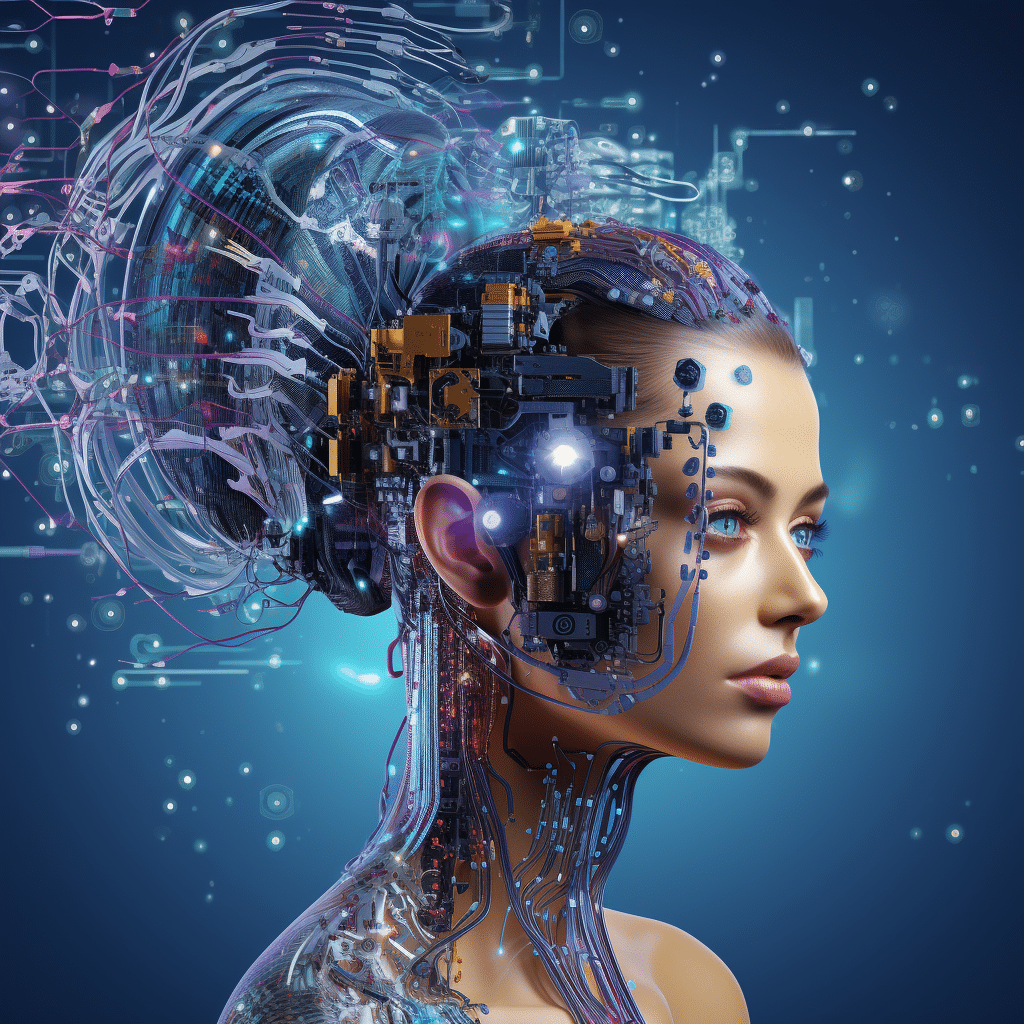
The Role of AI in Brain-Computer Interfaces
AI Advancements, Brain-Computer Interfaces (BCIs) are revolutionizing the relationship between humans and technology. By directly connecting the brain to external devices, BCIs allow individuals to control machines using their thoughts or obtain information related to brain activity in real-time. Artificial Intelligence (AI) plays a critical role in enhancing the capabilities of BCIs and making them more powerful and efficient.
AI algorithms, particularly machine learning techniques, enable BCIs to interpret brain signals and translate them into meaningful commands or actions. These algorithms analyze patterns and neural activity, learning from the user’s brain signals to identify specific commands or intentions. Machine learning algorithms improve their accuracy over time, adapting to individual users and effectively distinguishing between different commands or thoughts.
One of the key areas where AI contributes to BCIs is in brain mapping. Through advanced algorithms, AI allows for the precise identification and mapping of different brain regions involved in specific activities or actions. This information is crucial to enhance the accuracy of BCIs, as it helps to establish reliable correlations between brain signals and intended actions.
Brain-Computer Interfaces

Moreover, AI-powered BCIs facilitate the development of adaptive systems. By continuously analyzing and interpreting brain signals, AI algorithms can adjust the parameters of the interface in real-time, optimizing its performance based on the user’s needs, abilities, or even emotional state. This adaptability ensures that BCIs remain effective even in dynamic and changing conditions.
“AI-powered BCIs facilitate the development of adaptive systems, adjusting the parameters of the interface in real-time.”
AI Advancements plays a significant role in improving the accuracy and speed of decoding brain signals. Due to the complex and noisy nature of neural activity, signal processing is a challenging task. However, AI algorithms can effectively filter and interpret these signals, removing noise and extracting relevant information, leading to reliable control signals for BCIs.
Furthermore, AI advancements contribute to enhancing the usability of BCIs by implementing more natural and intuitive interaction paradigms. For instance, AI algorithms can enable BCIs to interpret imagined or intended movements, allowing users to control devices or prosthetics seamlessly. This progress brings us closer to a future where BCIs become effortlessly integrated into our daily lives.
AI Advancements plays a pivotal role in advancing Brain-Computer Interfaces. Through machine learning, brain mapping, adaptive systems, and improved signal processing, AI enhances the accuracy, speed, and usability of BCIs. As technology continues to rapidly evolve, AI-driven BCIs hold the promise of transforming the lives of individuals with limited mobility, neurodegenerative disorders, or any person seeking to unlock the full potential of their mind.
What are the key roles of AI in improving the accuracy and efficiency of brain-computer interfaces?
Artificial Intelligence (AI) plays key roles in improving the accuracy and efficiency of brain-computer interfaces (BCIs) in several ways:
1. Signal Processing:
AI algorithms can analyze and process neural signals received from the brain, enabling the identification and extraction of meaningful patterns. This helps in improving the accuracy of decoding brain activity and converting it into useful commands for BCIs.
2. Feature Extraction:
AI techniques can automatically extract relevant features from raw neural data. By identifying these features, AI algorithms can differentiate between different cognitive states or intentions, making BCIs more accurate and reliable.
3. Classification and Prediction:
AI models can classify and predict user intentions accurately based on the extracted features. These predictions help in determining the desired action or command from the user’s brain signals, allowing for seamless control of external devices and applications.
4. Adaptability and Personalization:
AI enables BCIs to adapt and learn from user interactions over time. Machine learning algorithms can adjust to individual differences in brain activity, enhancing the accuracy of the interface for each user. This adaptability also allows BCIs to compensate for changes in neural signals due to fatigue or other physiological factors.
5. Error Correction and Robustness:
AI algorithms can detect and correct errors in decoding or interpreting brain signals, increasing the reliability and efficiency of BCIs. By continuously monitoring and analyzing the neural data in real-time, AI can reduce false positives or false negatives in BCIs, improving the overall performance.
6. Automation and User Experience:
AI can automate certain processes in BCIs, such as calibration or data analysis, reducing the need for manual input and making the interface more user-friendly. Additionally, AI algorithms can provide feedback and suggestions to users, enhancing the overall user experience and facilitating better control over the BCIs.
Overall, AI plays a crucial role in enhancing the accuracy and efficiency of brain-computer interfaces by leveraging advanced signal processing, machine learning, and adaptive capabilities. AI Advancements, These advancements pave the way for more effective communication and control between humans and machines.
In what ways can AI algorithms contribute to enhancing the communication and control capabilities of brain-computer interfaces?
AI algorithms can contribute to enhancing the communication and control capabilities of brain-computer interfaces (BCIs) in several ways:
1. Signal Processing:
AI algorithms can efficiently process and analyze brain signals recorded by BCIs. This can help in filtering out noise, enhancing signal quality, and extracting relevant features from the brain signals.
2. Feature Extraction:
AI algorithms can extract meaningful features from the processed brain signals. These features can represent specific mental states or intentions of the user, enabling accurate control commands for BCIs.
3. Classification and Prediction:
AI algorithms can classify and predict the intentions or desired actions based on the extracted features. For example, they can determine if a user intends to move a cursor on a screen or perform a specific action.
4. Adaptive Learning:
AI algorithms can adapt and learn from the user’s input over time to improve the accuracy of BCI control. This allows the system to better understand the user’s unique brain patterns and adapt to changes in their neural activity.
5. Error Correction and Prediction:
AI algorithms can help in detecting and correcting errors or artifacts in the brain signals. They can predict and compensate for inaccuracies in the BCI system, leading to more reliable and robust control.
6. Natural Language Processing:
AI algorithms that incorporate natural language processing can facilitate communication between the user and the BCI. This enables users to convey their thoughts, commands, or queries by simply thinking or speaking, enhancing the communication capabilities of BCIs.
7. Neurofeedback:
AI algorithms can provide real-time feedback to the user, allowing them to modify their brain activity and improve control performance. This feedback loop helps users understand how their mental states are translated into BCI control and potentially enhance their control capabilities.
Overall, AI algorithms offer the potential to improve the performance, usability, and reliability of BCIs by enhancing communication and control capabilities, ultimately leading to more efficient and intuitive brain-computer interfaces.
What are the potential challenges and ethical considerations associated with integrating AI into brain-computer interfaces

There are several potential challenges and ethical considerations associated with integrating AI into brain-computer interfaces (BCIs). Some of these include:
1. Privacy and security:
BCIs collect and analyze sensitive data from the brain. The integration of AI raises concerns regarding the privacy and security of this data. Ensuring that user information is adequately protected and preventing unauthorized access is crucial.
2. Informed consent:
BCIs with AI capabilities may require users to provide informed consent for data collection and analysis. It is essential to establish robust protocols and ensure users understand the implications of sharing their brain data with AI systems.
3. Bias and fairness:
AI algorithms used in BCIs could be biased, leading to unfair outcomes for certain individuals or groups. Care must be taken to address potential biases and ensure fairness in the interpretation and use of brain data.
4. Reliability and accuracy:
The integration of AI in BCIs should aim to provide reliable and accurate results. If the AI systems are prone to errors or inaccuracies, it can have significant consequences for users, such as in medical diagnosis or assistive technologies.
5. Autonomy and agency:
BCIs with AI could potentially affect an individual’s autonomy and agency by interpreting or influencing their thoughts or actions. It is crucial to ensure that users retain control over their own thoughts and decisions and are not unduly influenced or manipulated by AI systems.
6. Unintended consequences and misuse:
The integration of AI in BCIs may have unintended consequences, such as unexpected side effects or impacts on mental health. Additionally, there is a risk of the technology being misused for unethical purposes, such as invasive surveillance or mind control.
7. Regulatory and legal frameworks:
Existing regulatory and legal frameworks may not adequately address the unique challenges posed by AI integration in BCIs. Developing appropriate regulations and laws to govern the ethical use of AI in these contexts is necessary to protect users’ rights and ensure responsible deployment.
8. Accessibility and equity:
BCIs with AI capabilities should be accessible to all individuals, regardless of their abilities or socioeconomic status. Ensuring equitable access and addressing potential disparities is crucial to prevent further marginalization or exclusion of certain populations.
AI Advancements is essential for researchers, developers, policymakers, and society at large to carefully consider and address these challenges and ethical considerations to promote the responsible and beneficial integration of AI into brain-computer interfaces.









Thanks for sharing. I read many of your blog posts, cool, your blog is very good.